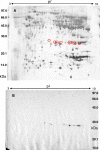Molecular cloning, biochemical characterization, and partial protective immunity of the heme-binding glutathione S-transferases from the human hookworm Necator americanus
- PMID: 20145100
- PMCID: PMC2849424
- DOI: 10.1128/IAI.00848-09
Molecular cloning, biochemical characterization, and partial protective immunity of the heme-binding glutathione S-transferases from the human hookworm Necator americanus
Abstract
Hookworm glutathione S-transferases (GSTs) are critical for parasite blood feeding and survival and represent potential targets for vaccination. Three cDNAs, each encoding a full-length GST protein from the human hookworm Necator americanus (and designated Na-GST-1, Na-GST-2, and Na-GST-3, respectively) were isolated from cDNA based on their sequence similarity to Ac-GST-1, a GST from the dog hookworm Ancylostoma caninum. The open reading frames of the three N. americanus GSTs each contain 206 amino acids with 51% to 69% sequence identity between each other and Ac-GST-1. Sequence alignment with GSTs from other organisms shows that the three Na-GSTs belong to a nematode-specific nu-class GST family. All three Na-GSTs, when expressed in Pichia pastoris, exhibited low lipid peroxidase and glutathione-conjugating enzymatic activities but high heme-binding capacities, and they may be involved in the detoxification and/or transport of heme. In two separate vaccine trials, recombinant Na-GST-1 formulated with Alhydrogel elicited 32 and 39% reductions in adult hookworm burdens (P < 0.05) following N. americanus larval challenge relative to the results for a group immunized with Alhydrogel alone. In contrast, no protection was observed in vaccine trials with Na-GST-2 or Na-GST-3. On the basis of these and other preclinical data, Na-GST-1 is under possible consideration for further vaccine development.
Figures







Similar articles
-
The evaluation of recombinant hookworm antigens as vaccines in hamsters (Mesocricetus auratus) challenged with human hookworm, Necator americanus.Exp Parasitol. 2008 Jan;118(1):32-40. doi: 10.1016/j.exppara.2007.05.010. Epub 2007 Jun 6. Exp Parasitol. 2008. PMID: 17645877
-
Structure of monomeric Na-GST-3, a glutathione S-transferase from the major human hookworm parasite Necator americanus.Acta Crystallogr Sect F Struct Biol Cryst Commun. 2013 Aug;69(Pt 8):839-43. doi: 10.1107/S1744309113017661. Epub 2013 Jul 27. Acta Crystallogr Sect F Struct Biol Cryst Commun. 2013. PMID: 23908024 Free PMC article.
-
Optimization and revision of the production process of the Necator americanus glutathione S-transferase 1 (Na-GST-1), the lead hookworm vaccine recombinant protein candidate.Hum Vaccin Immunother. 2014;10(7):1914-25. doi: 10.4161/hv.28872. Hum Vaccin Immunother. 2014. PMID: 25424799 Free PMC article.
-
Potency testing for the experimental Na-GST-1 hookworm vaccine.Expert Rev Vaccines. 2010 Oct;9(10):1219-30. doi: 10.1586/erv.10.107. Expert Rev Vaccines. 2010. PMID: 20923271 Review.
-
A history of hookworm vaccine development.Hum Vaccin. 2011 Nov;7(11):1234-44. doi: 10.4161/hv.7.11.18443. Epub 2011 Nov 1. Hum Vaccin. 2011. PMID: 22064562 Free PMC article. Review.
Cited by
-
Heme transport and erythropoiesis.Curr Opin Chem Biol. 2013 Apr;17(2):204-11. doi: 10.1016/j.cbpa.2013.01.010. Epub 2013 Feb 14. Curr Opin Chem Biol. 2013. PMID: 23415705 Free PMC article. Review.
-
Comparative proteomics of adult Paragonimus kellicotti excretion/secretion products released in vitro or present in the lung cyst nodule.PLoS Negl Trop Dis. 2022 Aug 17;16(8):e0010679. doi: 10.1371/journal.pntd.0010679. eCollection 2022 Aug. PLoS Negl Trop Dis. 2022. PMID: 35976975 Free PMC article.
-
Advancing a multivalent 'Pan-anthelmintic' vaccine against soil-transmitted nematode infections.Expert Rev Vaccines. 2014 Mar;13(3):321-31. doi: 10.1586/14760584.2014.872035. Epub 2014 Jan 6. Expert Rev Vaccines. 2014. PMID: 24392641 Free PMC article. Review.
-
Advances in neglected tropical disease vaccines: Developing relative potency and functional assays for the Na-GST-1/Alhydrogel hookworm vaccine.PLoS Negl Trop Dis. 2017 Feb 13;11(2):e0005385. doi: 10.1371/journal.pntd.0005385. eCollection 2017 Feb. PLoS Negl Trop Dis. 2017. PMID: 28192438 Free PMC article.
-
Sequence identification and expression profile of seven Dermacentor marginatus glutathione S-transferase genes.Exp Appl Acarol. 2020 Oct;82(2):295-308. doi: 10.1007/s10493-020-00546-7. Epub 2020 Sep 29. Exp Appl Acarol. 2020. PMID: 32995924 Free PMC article.
References
-
- Albonico, M., P. G. Smith, E. Ercole, A. Hall, H. M. Chwaya, K. S. Alawi, and L. Savioli. 1995. Rate of reinfection with intestinal nematodes after treatment of children with mebendazole or albendazole in a highly endemic area. Trans. R. Soc. Trop. Med. Hyg. 89:538-541. - PubMed
-
- Balloul, J. M., J. M. Grzych, R. J. Pierce, and A. Capron. 1987. A purified 28,000 dalton protein from Schistosoma mansoni adult worms protects rats and mice against experimental schistosomiasis. J. Immunol. 138:3448-3453. - PubMed
-
- Basavaraju, S., B. Zhan, M. W. Kennedy, Y. Liu, J. Hawdon, and P. J. Hotez. 2003. Ac-FAR-1, a 20 kDa fatty acid- and retinol-binding protein secreted by adult Ancylostoma caninum hookworms: gene transcription pattern, ligand binding properties and structural characterisation. Mol. Biochem. Parasitol. 126:63-71. - PubMed
Publication types
MeSH terms
Substances
Grants and funding
LinkOut - more resources
Full Text Sources
Research Materials

